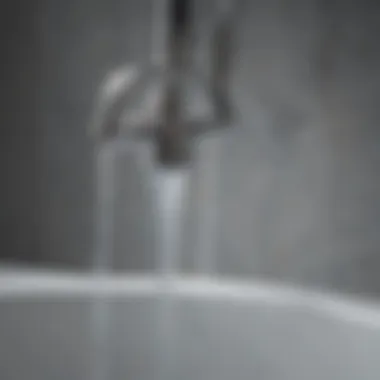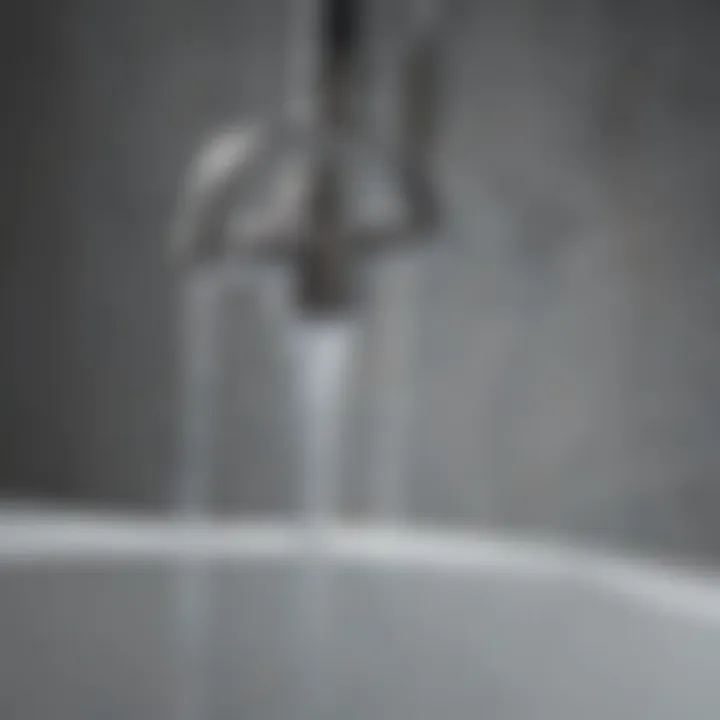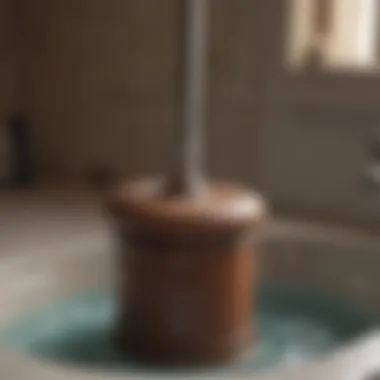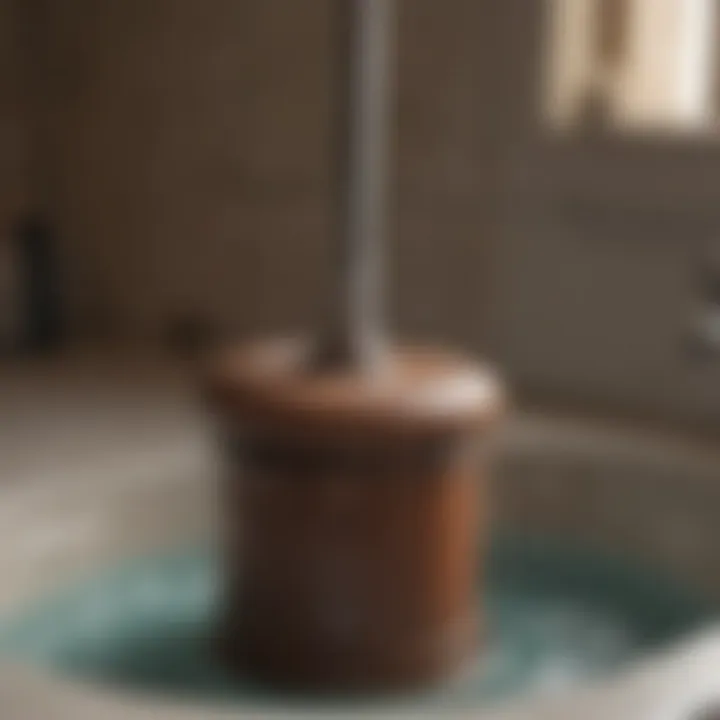Understanding Why Water Stagnates in Your Sink


Intro
A sink that refuses to drain can be an annoying and perplexing issue for homeowners and property managers alike. Understanding why water is not going down the sink is crucial for efficient troubleshooting and maintaining a smooth-running plumbing system. This article delves into a systematic exploration of the various reasons that can cause drainage problems and presents effective strategies for addressing them.
Some common causes include blockages, maintenance neglect, or even issues within specific plumbing mechanisms. Whether it's a simple clog or a more complex issue, pinpointing the root cause will allow for effective resolution.
Common Drainage Issues
Blockages
The most frequent culprit behind water backing up in a sink is blockage. Over time, debris such as hair, soap scum, and food particles can accumulate in drain pipes. This buildup restricts water flow and can lead to significant obstacles. Here are some common types of blockages:
- Hair Accumulations: Hair can easily wrap around drain components, forming a dense mass that disrupts water flow.
- Food Waste: Grease and small food particles can congeal in pipes, leading to severe blockages.
- Soap Scum: Certain types of soap can create a residue that sticks to the drain walls, narrowing the passage over time.
"Regular inspection and cleaning can prevent many drainage issues from escalating."
Pipe Damage
Another significant factor to consider is the potential for damage in the pipes themselves. Cracks or breaks in the plumbing can lead to leaks. When pipe integrity is compromised, water may not flow properly to the disposal system. Homeowners should be vigilant for:
- Visible Leaks: Water marks or pooling under sinks can indicate a leak.
- Poor Water Flow: Unusual slow drainage can be a sign of damage.
- Strange Noises: Gurgling sounds can signify trapped air within damaged pipes, leading to interrupted drainage.
These issues usually require the assistance of a skilled plumber for proper diagnosis and repair.
Maintenance and Prevention
Regular maintenance is key to ensuring that sinks drain effectively. Implementing easy practices can significantly reduce the chances of encountering serious drainage issues:
- Use Drain Screens: These devices can catch debris before it enters the pipe.
- Flush with Hot Water: Periodically flushing drains with hot water can help dissolve grease buildup.
- Avoid Chemical Cleaners: These may damage pipes in the long run and are often not as effective as other methods.
Understanding how to maintain your plumbing system can make a noticeable difference in performance.
Analyzing the Sink Mechanism
To gain a comprehensive understanding of sink drainage, it is essential to familiarize oneself with the different components involved in its mechanism. Key parts include:
- P-Trap: This curved pipe section helps prevent odors from entering the home. It can become blocked and should be cleaned regularly.
- Draining Vent: Improper ventilation can lead to slow drainage. Ensure vents are clear of debris.
By inspecting these components, a homeowner can identify and rectify potential issues before they escalate.
Preface to Drainage Issues
Understanding drainage issues is essential for any homeowner or property manager. Inadequate drainage can lead to a variety of problems, including backups, unpleasant odors, and potential water damage. This article aims to illuminate the reasons behind drainage problems and offer insights into their resolution. Often, noticing recurring issues in a sink can signal a larger plumbing concern. Homeowners should take these signs seriously to prevent costly repairs in the long run.
The Importance of Effective Drainage
Effective drainage serves multiple crucial functions within a home. Properly functioning drainage prevents not only water buildup but also the growth of mold and bacteria that thrive in damp conditions. When water does not flow freely, it creates an environment where issues can escalate quickly.
Additionally, systems that drain efficiently contribute positively to the overall functionality and hygiene of a household. A well-drained sink, for instance, ensures that kitchen waste or bathroom products do not linger, promoting a tidy space.
By prioritizing effective drainage, homeowners can maintain the longevity of their plumbing systems while promoting a healthier living environment. This proactive approach also helps in saving costs associated with emergency repairs or extensive renovations.
Common Experiences with Clogged Sinks
Experiencing a clogged sink is a common scenario in many homes. This issue may manifest in various ways, signaling the onset of drainage problems. Some typical experiences include:
- Slow Draining: Water takes longer than usual to drain, often leaving a puddle.
- Backflow: Water may rise back into the sink, indicating a serious blockage.
- Standing Water: Puddles often remain stagnant, which can cause odors and attract pests.
Each of these experiences contributes to inconvenience and annoyance, prompting many to seek solutions. Understanding these signs can empower homeowners to take action before conditions worsen.
Initial Diagnosis
Understanding the initial diagnosis provides an essential framework for addressing drainage issues effectively. Knowing the right steps to take can save time, resources, and potential damage in your plumbing system. The identification of symptoms and assessing situations through specific techniques allows homeowners and property managers to pinpoint the exact problems.
A systematic approach to diagnosis not only enhances the likelihood of correctly addressing the issue but also empowers individuals to respond to similar problems in the future.
Identifying the Symptoms
Slow Draining


Slow draining is often one of the earliest signs of a clog. Water takes longer to leave the sink, which can be frustrating. This condition often signifies an accumulation of debris within the pipes that hinders water flow. The key characteristic of slow draining is the consistent delay in water disappearance.
Identifying this symptom early can prevent further complications, such as more serious clogs.
One unique feature of slow draining is its gradual nature. It does not occur suddenly, allowing homeowners the chance to observe changes over time. However, ignoring this symptom may lead to complete blockages eventually, which can necessitate more invasive measures.
Backflow
Backflow represents a more critical symptom, indicating a severe issue within the plumbing system. When water flows backward into the sink, it can bring debris and waste materials along. This issue points to significant obstructions in the drainage system. The key characteristic of backflow is its unexpected appearance, which can sometimes be alarming.
This symptom's presence suggests that the drainage system is overwhelmed, often due to clogs further down the line. Its unique feature is the potential health risk it poses, as backflow may introduce contaminants.
Immediate attention to backflow is necessary to avoid more significant problems, including disease or further damage to your plumbing.
Standing Water
Standing water in the sink represents a critical failure in drainage. Unlike slow draining or backflow, standing water is a clear symptom that indicates a complete blockage. Water accumulation at the sink not only points to a clog but can also lead to more severe problems, such as water damage and mold growth.
The key characteristic here is that water remains visible, stagnant, with no signs of draining. Its unique feature lies in the fact that it often requires immediate action to avoid further damage to the property. Conditions such as standing water might necessitate the use of specialized tools or professional assistance to resolve effectively.
Assessing the Situation
Assessing the situation involves two primary techniques: visual inspection and noise assessment. This process aids in obtaining a clearer understanding of the plumbing conditions, thus enabling accurate troubleshooting.
Visual Inspection
Visual inspection is a straightforward yet effective method to check for potential issues. Observing the sink, pipes, and surrounding areas can reveal signs of leaks, corrosion, or visible blockages. The key characteristic of visual inspection is its ability to provide immediate clues regarding the problem.
This technique is beneficial because it requires no special tools or skills. A keen eye often catches issues early and dramatically decreases the chance of escalating problems. On the downside, it may miss issues concealed within the pipes.
Noise Assessment
Noise assessment involves listening for unusual sounds when the sink is in use. Gurgling or bubbling can indicate pressure issues within the drainage system. This approach relies on the characteristic sounds that arise during water flow, helping to diagnose potential clogs hidden from view.
Utilizing noise assessment allows individuals to gather information with minimal effort. However, it requires a certain level of familiarity with normal plumbing sounds. Understanding these can be essential for effective troubleshooting.
"Identifying symptoms early can prevent further complications and save significant costs in plumbing repair."
Common Causes of Drainage Problems
Understanding common causes of drainage problems is crucial for anyone experiencing issues with their sink. These problems can lead to frustration and costly repairs if not addressed promptly. Identifying the specific type of blockage or malfunction is essential to find an effective solution. It can also save time and prevent further damage to plumbing systems. This section dives into the most frequent culprits behind water not flowing down sinks, offering insights that are practical to homeowners and property managers alike.
Physical Blockages
Physical blockages are one of the most common reasons for drainage problems. They can occur for various reasons, often resulting in slow draining or completely clogged sinks. Recognizing these blockages early on can help in mitigating severe plumbing issues later.
Hair Accumulation
Hair accumulation is a significant factor causing clogs in bathroom sinks. It often gathers in the drain, creating a dense mass that prevents water passage. When hair combines with soap scum and other residues, it creates a stubborn blockage. Regular cleaning of drains can help control this issue. While it is easy for many to overlook, hair accumulation is a prevalent problem. Additionally, it can lead to severe plumbing problems if untreated for long periods.
Food Particles
Food particles are another key aspect contributing to drainage issues, especially in kitchen sinks. When food is rinsed off plates or washed down the drain, it can build up over time, leading to blockages. Even small bits of food can accumulate and lead to significant problems. Keeping strainers in sinks can help minimize food particle accumulation. It’s a simple yet effective means to maintain clear drains, save time, and avoid future plumbing difficulties.
Soap Scum
Soap scum is the residue that builds up in sinks due to soap use. It can cling to the sides of pipes, reducing the diameter for water flow. Over time, this buildup can lead to slow drainage or clogs. Regular cleaning and the use of drain cleaning solutions can mitigate soap scum's effects. While it can be removed, ignoring this residue can lead to more extensive maintenance work down the line.
Pipe Issues
Pipe issues are often more serious than physical blockages. They can cause severe damage if not addressed. Understanding the types of pipe issues that can occur is essential for any homeowner.
Pipe Bends
Pipe bends refer to the changes in direction that plumbing pipes must take. While they are necessary for proper drainage systems, excessive bending can create areas where debris accumulates. This can lead to slow drainage. Inspecting the plumbing layout for unnecessary bends can help alleviate issues. Ensuring proper angles in plumbing can lead to more effective drainage in the long run.
Collapsed Pipes
Collapsed pipes present a severe issue for any plumbing system. This situation can happen due to various reasons, including ground movement or pressure on the pipes from surrounding soil. When a pipe collapses, water cannot flow, causing backups. This issue often requires considerable repairs. If homeowners notice drastic drainage changes, it is essential to call a professional to inspect for potential pipe collapse.


Ventilation Problems
Ventilation problems may not be as obvious but are critical in maintaining proper drainage. They can lead to ineffective flow or allow foul odors to infiltrate living spaces.
Blocked Vent Pipes
Blocked vent pipes can disrupt the balance in a plumbing system, causing symptoms like slow draining or gurgling noises. Vent pipes allow air into the system, which helps with water flow. If these pipes become blocked, it can lead to significant drainage issues. Regular inspection and clearing of vent pipes can prevent this problem from worsening.
Improper Vent Installation
Improper vent installation can lead to numerous plumbing challenges. If vent pipes are not installed correctly, it can obstruct airflow, which in turn affects drainage. This issue may lead to increased pressure build-up and eventual pipe damage. Ensuring proper installation can save future headaches, and it's wise to consult with a plumbing professional during renovations or repairs.
Identification Techniques and Tools
When dealing with a sink that won’t drain, understanding the proper identification techniques and tools is essential. These methods enable homeowners to pinpoint the root cause of the blockage effectively. When one understands the issue, it becomes much easier to take the necessary steps toward resolution. Moreover, employing the right tools can streamline the troubleshooting process, reducing frustration and potential damage to plumbing.
Using a Plunger
A plunger is often the first tool that comes to mind when addressing clogged sinks. Its simple design, consisting of a rubber suction cup and a wooden or plastic handle, makes it effective for dislodging blockages. To use it effectively, one should cover any overflow openings to ensure maximum pressure is applied. Place the plunger over the drain opening and pump it with consistent force. The suction and pressure created can help break up the obstruction, leading to improved drainage. Regularly practicing this technique can save time and potentially costly call-outs to professionals.
Employing a Drain Snake
For clogs that a plunger cannot resolve, a drain snake is another valuable tool. This tool consists of a long, flexible metal wire that can navigate through pipes. When using a drain snake, one should insert the end of the snake into the drain and twist it to break apart the blockage. It is crucial to proceed gently, as excessive force can damage the plumbing. Engaging in this technique may require some practice, but it is effective for deeper, more stubborn obstructions. The drain snake can help clear hair, grease, and other hard-to-reach materials.
Chemical Drain Cleaners
Chemical drain cleaners are a more aggressive option for maintaining your plumbing. These products contain potent substances designed to dissolve organic materials causing the blockage. They can be effective but must be used with caution. First, always follow the manufacturer’s instructions, as improper use can damage pipes, especially if they are old or made from specific materials. Also, ensure you are in a well-ventilated area when using these cleaners to avoid inhaling harmful fumes. Sometimes, these cleaners can provide a straightforward option for minor clogs, making them a useful addition to one's plumbing toolkit.
Important Note: Always consider the environmental impact of chemical cleaners before use.
In summary, employing identification techniques and tools when facing drainage problems is crucial. Using a combination of a plunger, drain snake, and chemical cleaners can assist effectively in diagnosing and resolving the issue, ultimately leading to a well-maintained plumbing system.
Preventative Measures
Preventative measures are crucial in maintaining proper drainage in sinks. A proactive approach helps to avoid costly repairs and headaches from blocked systems. Homeowners can save time and money by adopting simple strategies that promote effective drainage. These measures ensure that potential problems are minimized before they escalate into severe issues.
Routine Maintenance Practices
Regular Cleaning
Regular cleaning is fundamental in keeping drains functioning effectively. This practice involves clearing debris and buildup from the sink, including food residues and grease. The key characteristic of regular cleaning is its frequency; incorporating this practice into a weekly routine enhances the sink's overall performance. This is especially beneficial in households with heavy cooking activities that introduce various contaminants into the drainage system.
One unique feature of regular cleaning is its adaptability. Homeowners can choose from multiple methods, such as using hot water, vinegar, or baking soda, which offer environmentally friendly options alongside traditional chemical cleaners. The main advantage lies in the reduction of clogs, promoting smooth water flow. However, it can be time-consuming, requiring discipline and consistent effort.
Installation of Drain Guards
Installation of drain guards is another effective preventative measure. These devices are placed over drains to catch food particles and other debris before they enter the plumbing system. The primary characteristic of drain guards is their simplicity and effectiveness in minimizing clogs. By trapping potential blockages, they serve as a protective barrier, making them a popular choice for preventing sink issues.
These guards often feature mesh or filtered designs that allow water to flow freely while keeping larger materials out. This unique feature significantly reduces the frequency of drain cleanings and professional interventions. On the downside, drain guards must be cleaned regularly to maintain their effectiveness, which may require additional care from users.
Educating Household Members
Educating household members about proper disposal practices is essential for maintaining an efficient drainage system. By fostering an awareness of what can and cannot be put down the sink, homeowners can significantly extend the lifespan of their plumbing.
Proper Disposal Techniques
Proper disposal techniques focus on ensuring that only suitable materials enter the sink. This aspect highlights the importance of distinguishing between compostable waste and harmful substances. Encouraging everyone in the household to follow these guidelines greatly contributes to the overall goal of keeping drains unclogged. The key characteristic of proper disposal techniques lies in their educational value; teaching members prevents mishaps before they happen.
The unique feature of proper disposal techniques is their adaptability. Families can tailor their rules based on what is most relevant to their daily habits. An advantage is that it promotes a larger sense of responsibility within the household. However, the challenge is that adherence to these practices may take time and require consistent reinforcement.
Managing Waste
Managing waste in the kitchen is crucial to an efficient drainage system. This practice involves disposing of food waste appropriately, ensuring that there is minimal residue remaining in the sink or disposal. The key characteristic of managing waste is its holistic approach; it combines several techniques, including composting and recycling, to reduce overall waste production.
One unique feature of managing waste is its focus on sustainability. By integrating environmentally friendly methods, such as using compost bins, households can minimize the amount of unnecessary debris that enters the drainage system. This practice helps maintain a cleaner sink environment. The main challenge is fostering lifestyle changes that require discipline and education within the household. It's essential to regularly remind everyone of the benefits of managing waste effectively.
Understanding Plumbing Systems
Understanding plumbing systems is crucial when addressing drainage issues, especially when water is not going down the sink. Plumbing is the backbone of any building's water flow and waste removal, fundamental for both functionality and hygiene. Through comprehending plumbing systems, homeowners and property managers can anticipate problems and take preventive measures.


Being familiar with basic plumbing components allows for more effective troubleshooting. This knowledge leads to timely interventions, reducing the likelihood of costly repairs caused by neglect or misunderstanding.
Basic Plumbing Components
Pipes
Pipes are central to any plumbing system, serving as conduits for water flow. The material of pipes can vary; some common types include PVC, copper, and galvanized steel. Each of these materials has distinct properties that affect durability, cost, and installation methods. PVC pipes, for instance, are favored for their affordability and ease of installation, making them a beneficial option for homeowners seeking solutions for small drainage issues.
One unique feature of pipes is that they can corrode over time, especially those made of metal. This can lead to obstructions in flow, which is especially relevant in the context of sinks that are not draining properly. Corroded pipes can be a hidden problem, necessitating routine inspections to ensure efficient functionality.
Traps
Traps, specifically P-traps, are essential components located beneath sinks that prevent sewer gases from entering living spaces. They maintain a small amount of water to create a barrier against odors. This key characteristic makes traps an indispensable part of kitchen and bathroom sinks, ensuring both safety and sanitation.
However, traps can become clogged with debris like hair and food particles. This blockage creates significant drainage issues. When addressing concerns about water drainage, understanding the role of traps offers insight into potential sources of problems. It allows for targeted cleaning efforts, minimizing inconvenience and improving overall efficiency.
Bends
Bends are the sections of pipe that change direction, allowing plumbing systems to fit within confined spaces. These are often designed with specific angles to facilitate flow while minimizing resistance. The key characteristic of bends is their ability to optimize water flow despite alterations in direction, which can be beneficial in complex plumbing configurations.
However, bends can also collect debris over time. If there is a significant collection of waste in bends, it may become a site for blockages. This aspect highlights the importance of knowing the layout of plumbing in a dwelling, particularly for effective maintenance and timely interventions during drainage problems.
Working Mechanisms of Sinks
Working mechanisms of sinks involve understanding how water is supposed to flow, the role of gravity, and what happens during a clog. Sinks typically use gravity to dispose of waste, relying on properly functioning plumbing systems. Understanding these mechanisms can aid in identifying where the breakdown occurs when faced with drainage issues.
Addressing sink drainage problems becomes less daunting with a solid grasp on basic components and their functions. Taking time to understand plumbing systems is not only a beneficial practice for immediate repairs but also for long-term maintenance strategies.
When to Call a Professional
In situations where water is not draining from the sink effectively, it is crucial to recognize when to involve a professional plumber. This decision can save time, costs, and potential damage to property. Identifying the right moments for professional help can prevent minor issues from becoming major disasters.
Signs of Serious Problems
Persistent Clogs
Persistent clogs develop over time, indicating a deeper issue often lurking in the plumbing system. They often become evident when water drains slowly or not at all. A significant characteristic of a persistent clog is its tenacity; it does not respond well to conventional methods like plunging or using drain snakes. It indicates that the blockage is likely beyond the immediate reach of standard home remedies. It could consist of a buildup of debris, such as grease, food particles, or even tree roots infiltrating more extensive pipe networks.
Why is recognizing persistent clogs pivotal in this article? They symbolize a link to potential serious plumbing problems. If unresolved, they can lead to severe functionality loss and plumbing system breakdown.
The unique feature of a persistent clog lies in its evolution. If left untreated, it can damage pipes through corrosion or increased pressure, leading to leaks. On the other hand, addressing it early with professional help can restore proper drainage effectively.
Water Damage
Water damage is another significant red flag homeowners must heed. It manifests through signs like damp walls, ceilings, or even floors. The crucial aspect of water damage is its hidden nature; it can silently destroy a home for long periods before noticeable symptoms appear. Unlike a visible clog, water damage may arise from slow leaks or consistent overflows.
The primary concern about water damage is its profound impact on a home’s structure. It compromises the integrity of walls and foundations, leading to costly repairs. Thus, recognizing its presence is not only beneficial but essential for maintaining property health.
A distinctive feature of water damage lies in its potential to foster mold growth. This aspect not only exasperates the damage but also creates health hazards. Engaging a professional to assess the extent of such damage can offer homeowners clarity and direction for restoration.
Benefits of Professional Assessment
There are numerous advantages to seeking a professional assessment in plumbing issues. Firstly, professionals possess the experience and tools to diagnose problems accurately. Their training allows them to identify underlying issues that may not be apparent to untrained eyes.
Additionally, professionals can facilitate quicker resolutions. They understand the plumbing systems thoroughly and can adopt a tailored approach to each problem. This usually results in reduced time spent dealing with the issue for the homeowner.
Furthermore, preventative advice is a key benefit. After resolving the current issue, professionals often recommend steps to avert future problems. They can advise on maintenance routines and products that could improve the longevity of your plumbing system.
In summary, when a homeowner encounters persistent clogs or signs of water damage, involving a professional is often the wisest choice. The immediate cost may seem high, but potential savings from avoiding extensive damage and ensuring proper functioning justify this action.
Culmination
In this exploration of drainage issues, we reached an important understanding of why water may not be flowing down the sink effectively. The topic is significant for homeowners and property managers alike, as unresolved drainage problems can lead to broader plumbing issues or even structural damage. By recognizing the symptoms and causes, individuals can prevent minor inconveniences from escalating into costly repairs.
Summary of Key Points
This article has reviewed various aspects related to sink drainage, including symptoms such as slow draining and persistent clogs. We examined common causes, from physical blockages like food particles and hair accumulation to complex pipe issues and ventilation problems. Understanding plumbing systems and available diagnosis tools, like plungers and drain snakes, is essential for effective troubleshooting. Furthermore, we highlighted the importance of routine maintenance practices to avoid future problems.
Future Maintenance Considerations
To maintain effective drainage, several proactive measures can be adopted:
- Regular Inspections: Schedule routine checks of your plumbing system to catch minor issues before they worsen.
- Use Drain Guards: Installing these can significantly reduce the amount of debris that enters the drainage system.
- Educate Household Members: Providing guidance on proper disposal methods and waste management can prevent avoidable clogs.
By implementing these tactics, homeowners can protect their plumbing and ensure it operates smoothly for years to come.















